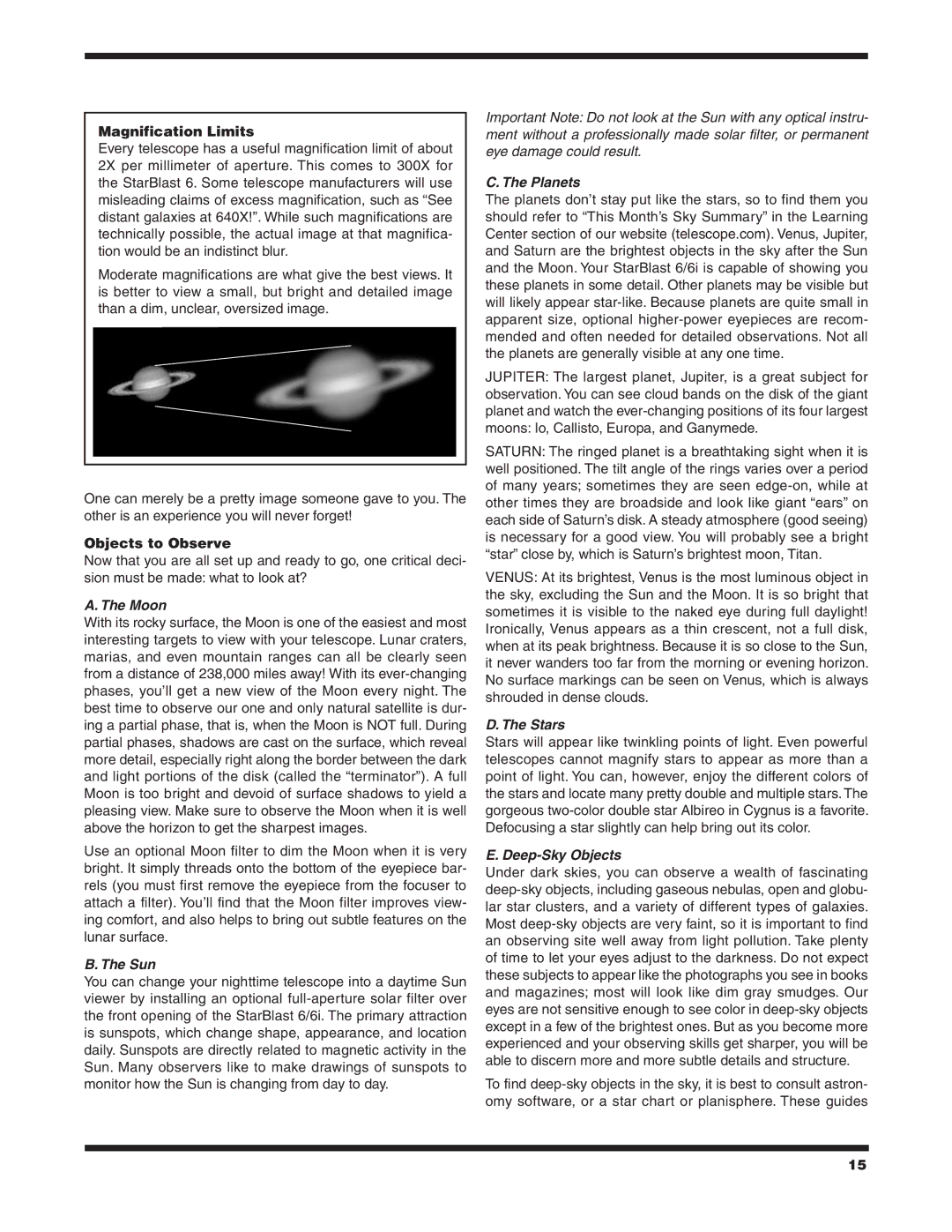Magnification Limits
Every telescope has a useful magnification limit of about 2X per millimeter of aperture. This comes to 300X for the StarBlast 6. Some telescope manufacturers will use misleading claims of excess magnification, such as “See distant galaxies at 640X!”. While such magnifications are technically possible, the actual image at that magnifica- tion would be an indistinct blur.
Moderate magnifications are what give the best views. It is better to view a small, but bright and detailed image than a dim, unclear, oversized image.
One can merely be a pretty image someone gave to you. The other is an experience you will never forget!
Objects to Observe
Now that you are all set up and ready to go, one critical deci- sion must be made: what to look at?
A. The Moon
With its rocky surface, the Moon is one of the easiest and most interesting targets to view with your telescope. Lunar craters, marias, and even mountain ranges can all be clearly seen from a distance of 238,000 miles away! With its ever-changing phases, you’ll get a new view of the Moon every night. The best time to observe our one and only natural satellite is dur- ing a partial phase, that is, when the Moon is NOT full. During partial phases, shadows are cast on the surface, which reveal more detail, especially right along the border between the dark and light portions of the disk (called the “terminator”). A full Moon is too bright and devoid of surface shadows to yield a pleasing view. Make sure to observe the Moon when it is well above the horizon to get the sharpest images.
Use an optional Moon filter to dim the Moon when it is very bright. It simply threads onto the bottom of the eyepiece bar- rels (you must first remove the eyepiece from the focuser to attach a filter). You’ll find that the Moon filter improves view- ing comfort, and also helps to bring out subtle features on the lunar surface.
B. The Sun
You can change your nighttime telescope into a daytime Sun viewer by installing an optional full-aperture solar filter over the front opening of the StarBlast 6/6i. The primary attraction is sunspots, which change shape, appearance, and location daily. Sunspots are directly related to magnetic activity in the Sun. Many observers like to make drawings of sunspots to monitor how the Sun is changing from day to day.
Important Note: Do not look at the Sun with any optical instru- ment without a professionally made solar filter, or permanent eye damage could result.
C. The Planets
The planets don’t stay put like the stars, so to find them you should refer to “This Month’s Sky Summary” in the Learning Center section of our website (telescope.com). Venus, Jupiter, and Saturn are the brightest objects in the sky after the Sun and the Moon. Your StarBlast 6/6i is capable of showing you these planets in some detail. Other planets may be visible but will likely appear star-like. Because planets are quite small in apparent size, optional higher-power eyepieces are recom- mended and often needed for detailed observations. Not all the planets are generally visible at any one time.
JUPITER: The largest planet, Jupiter, is a great subject for observation. You can see cloud bands on the disk of the giant planet and watch the ever-changing positions of its four largest moons: Io, Callisto, Europa, and Ganymede.
SATURN: The ringed planet is a breathtaking sight when it is well positioned. The tilt angle of the rings varies over a period of many years; sometimes they are seen edge-on, while at other times they are broadside and look like giant “ears” on each side of Saturn’s disk. A steady atmosphere (good seeing) is necessary for a good view. You will probably see a bright “star” close by, which is Saturn’s brightest moon, Titan.
VENUS: At its brightest, Venus is the most luminous object in the sky, excluding the Sun and the Moon. It is so bright that sometimes it is visible to the naked eye during full daylight! Ironically, Venus appears as a thin crescent, not a full disk, when at its peak brightness. Because it is so close to the Sun, it never wanders too far from the morning or evening horizon. No surface markings can be seen on Venus, which is always shrouded in dense clouds.
D. The Stars
Stars will appear like twinkling points of light. Even powerful telescopes cannot magnify stars to appear as more than a point of light. You can, however, enjoy the different colors of the stars and locate many pretty double and multiple stars. The gorgeous two-color double star Albireo in Cygnus is a favorite. Defocusing a star slightly can help bring out its color.
E. Deep-Sky Objects
Under dark skies, you can observe a wealth of fascinating deep-sky objects, including gaseous nebulas, open and globu- lar star clusters, and a variety of different types of galaxies. Most deep-sky objects are very faint, so it is important to find an observing site well away from light pollution. Take plenty of time to let your eyes adjust to the darkness. Do not expect these subjects to appear like the photographs you see in books and magazines; most will look like dim gray smudges. Our eyes are not sensitive enough to see color in deep-sky objects except in a few of the brightest ones. But as you become more experienced and your observing skills get sharper, you will be able to discern more and more subtle details and structure.
To find deep-sky objects in the sky, it is best to consult astron- omy software, or a star chart or planisphere. These guides

